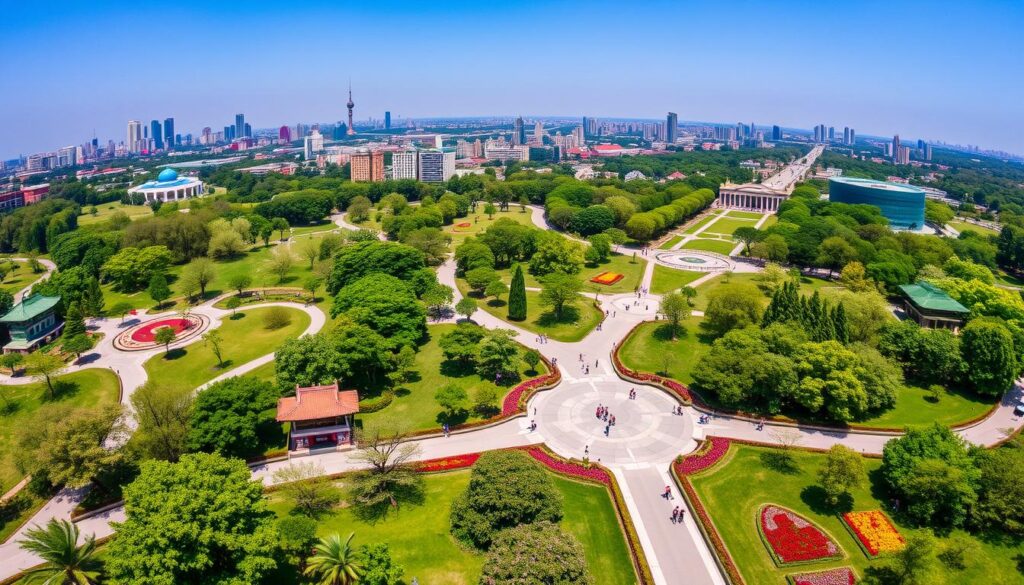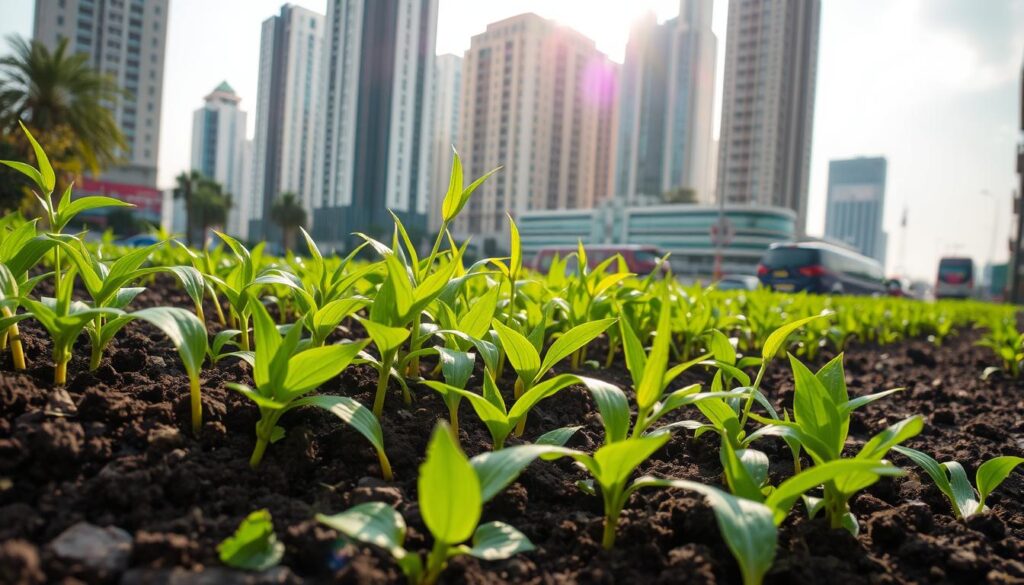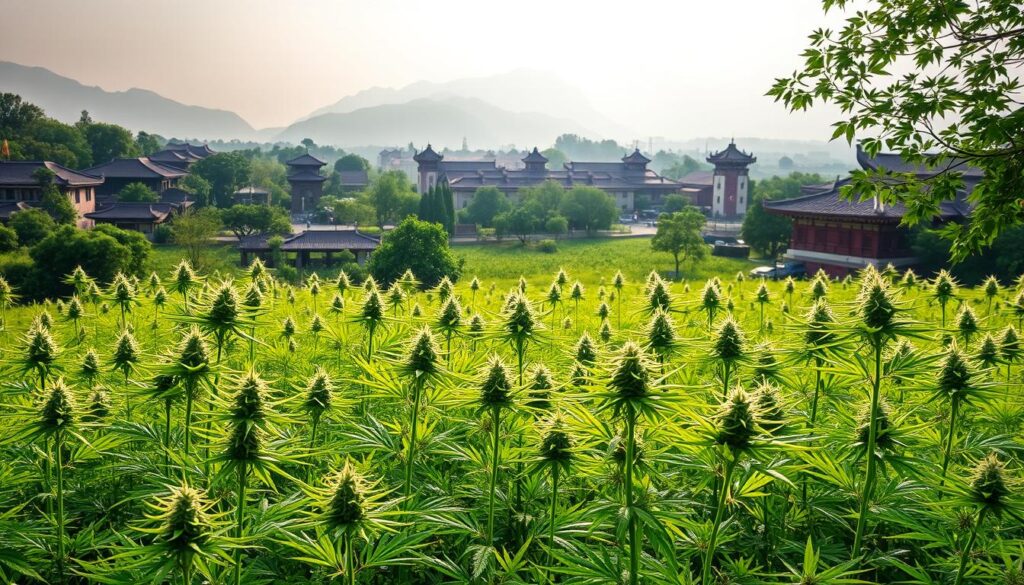Tianjin’s plants are more than just greenery. They show a world of diversity. Weed in Tianjin is a complex system with its own rules.
The city’s weather and buildings shape how plants grow. Studying marijuana in Tianjin needs a careful look at local plants.
Exploring Tianjin’s green areas shows how plants adapt. You’ll learn about their survival tricks.
Researchers found many weed types in Tianjin. They show how plants can thrive in tough city spots. The variety of plants shows how resilient they are in northern China.
Key Takeaways
- Tianjin hosts a diverse range of weed species across multiple ecological zones
- Urban environments significantly impact plant growth and distribution
- Local botanical research provides deep insights into plant adaptation
- Climate plays a crucial role in vegetation survival strategies
- Understanding local plant ecosystems requires comprehensive scientific investigation
Understanding Tianjin’s Flora and Vegetation Patterns
Tianjin’s nature is a mix of plants that show how Northern China’s environment works. The plants face challenges like water use and city growth. These issues are like the problems in illegal drug trade in Tianjin.
Native Plant Species Distribution
The Binhai wetlands cover over 340 square kilometers. They have many types of plants. When you visit, you see:
- Salt marsh plants that can handle tough conditions
- Plants that live in fresh water
- Plants made for artificial wetlands
Seasonal Growth Patterns
Plant growth in Tianjin changes with the seasons. Just like drug trade in China, it’s hard to predict. Spring is when plants start to grow fast, reacting to their surroundings.
Common Vegetation Zones
The North China Plain, where Tianjin is, has a unique plant world. The plants show how farming and cities grow together. It’s like the secret world of black market drugs in Asia.
| Vegetation Zone | Characteristics | Dominant Species |
|---|---|---|
| Wetland Areas | High moisture content | Reed species, aquatic plants |
| Urban Green Spaces | Managed ecosystems | Ornamental and adaptive species |
| Agricultural Zones | Cultivated landscapes | Wheat, maize, seasonal crops |
*”Vegetation tells the story of a landscape’s resilience and adaptation.”*
The Current State of Weed in Tianjin
Looking at weed in Tianjin means we must understand the local plants and farming challenges. The area’s special weather and soil make it hard for plants to grow well.
Studies on growing marijuana in Tianjin show interesting facts. Even though growing weed is banned in China, the local plants show how they adapt and survive.
- Native weed species are very strong
- Agricultural areas have different plants
- Weather and soil affect plant growth
*”Plant diversity shows how complex urban and farm areas are”* – Tianjin Botanical Research Institute
Looking at weed in Tianjin, we find some plants are more common than others. Here are a few important ones:
| Weed Species | Prevalence | Impact Level |
|---|---|---|
| Ixeris polycephala Cass. | High | Dominant |
| Taraxacum mongolicum Hand.-Mazz | Moderate | Significant |
| Inula japonica Thunb. | Low | Moderate |
When we talk about growing weed in China, we must remember the strict rules. The government has always been careful about plants and drugs.
Managing weeds in Tianjin needs smart plans for plants and farms.
Historical Context of Plant Communities in Northern China
Northern China’s plants show a mix of old farming and new city growth. The area’s plants have changed a lot. This is due to old ways and new city growth.
Traditional Agricultural Practices
Old farming in Northern China was all about caring for the land. Farmers used special methods to keep the land healthy. They did this even when facing problems like illegal drug trade in Tianjin.
- Crop rotation methods preserving soil health
- Water conservation techniques
- Integrated pest management strategies
“The land speaks through its plants, telling stories of generations of careful cultivation.” – Traditional Chinese Agricultural Wisdom
Evolution of Urban Green Spaces
Tianjin’s city has changed a lot, showing how China views nature. The city’s green areas are key to fighting drug problems. They make the city a better place to live.
Important changes in green spaces include:
- More money for public parks
- Using native plants
- Green projects to fight black market drugs in Asia
The plant communities of Northern China show a mix of old culture and new city planning.
Mapping Tianjin’s Green Areas and Parks

Tianjin’s cityscape is full of green spaces. These areas are key to the city’s health. A big survey was done in 23 places to see how green it is.
Experts have mapped out Tianjin’s green spots. They learned a lot about plants in the city. They looked at where people might grow marijuana and make cannabis.
“Green spaces are the lungs of our urban environment, offering more than just aesthetic value.” – Urban Ecology Research Team
- Total surveyed green areas: 23 sites
- Geographic coverage: Entire Tianjin municipality
- Primary research objectives: Vegetation mapping and ecosystem analysis
The survey gave important info to city planners. It shows how green spaces help the city. This is very important for the economy, especially in the Beijing-Tianjin-Hebei area.
| Ecosystem Service Indicator | Economic Value (2012) | Percentage of GDP |
|---|---|---|
| Tianjin PES Standards | 13.8 billion yuan | 0.77% |
| Beijing-Tianjin-Hebei Region | 19.2 billion yuan | 1.49% |
Note: The data shows how much green spaces help the city’s economy. They help manage the environment and support growth.
Common Plant Species Identification in Tianjin
Tianjin’s plants show a rich and complex world. This world is shaped by the area’s special environment. Knowing about plants helps us see the region’s ecological patterns.
Tianjin’s plants are diverse and complex. Recent studies show interesting facts about the area’s plant life. This includes urban areas like the Lingang Urban Ecological Wetland Park.
Broadleaved Species Distribution
Tianjin’s plants are very diverse. They have many different types. Here are some key facts:
- 246 vascular plant species
- 171 genera across 73 different plant families
- 79.6% herb species
- 31.7% arbor plants
- 16.7% shrub varieties
Perennial Plant Varieties
Perennial plants are very important in Tianjin. They are often ignored by drug traffickers. But scientists know they are key to understanding local biodiversity.
| Plant Category | Percentage | Dominant Families |
|---|---|---|
| Dicotyledonous Plants | 134 genera | Rosaceae, Asteraceae |
| Monocotyledonous Plants | 31 genera | Gramineae |
| Gymnosperm Species | 16 families | Various genera |
Annual Growth Varieties
The black market drugs Asia trade gets a lot of attention. But Tianjin’s annual plant growth is more complex. Wild plants make up 31.3% of the total. Cultivated plants make up 68.7%.
“In every seed lies the potential of an entire ecosystem” – Tianjin Botanical Research Institute
Learning about these plants gives us a deeper look at Tianjin’s ecosystem. It shows the area’s rich plant heritage, beyond simple stories.
Environmental Factors Affecting Plant Growth

Weed in Tianjin has a complex environment. This affects how plants grow. The area’s special conditions change how marijuana and cannabis grow in China.
In 2015 and 2016, scientists learned a lot. They found out about the plants in the area:
- Perennial weeds made up 45.9% of the plants
- Annual and biennial weeds were 54.1%
- The Asteraceae family was 43.2% of the species
- Most plants had broad leaves, 94.6%
Climate and soil are very important. Temperature, rain, and soil type affect plants in Tianjin’s cities and countryside.
“Environmental factors are the silent architects of botanical ecosystems” – Tianjin Ecological Research Institute
Important things that affect plants include:
- Soil organic matter content
- Salinity levels
- Nutrient composition
- Moisture availability
- Temperature variations
Soil and salt levels affect plant growth. The special environment in Tianjin makes it great for growing weeds and plants.
Urban Development Impact on Local Flora
Tianjin’s city is changing fast. This change makes managing green spaces hard. The city’s growth meets environmental needs, especially in areas with new buildings and roads.
Building new things changes the plants and their places. As the city grows, finding a balance between buildings and nature is key.
Construction’s Environmental Consequences
Building in Tianjin affects the plants. It can mess up where plants live and grow. This might help illegal drug trade find new paths in the city.
- Reduction of green spaces
- Soil composition alterations
- Displacement of native plant species
Strategic Green Space Management
Managing green spaces well is very important. Cities like Tianjin face big challenges. They must deal with drug trade while redesigning the city.
| Management Strategy | Environmental Impact |
|---|---|
| Native Species Preservation | Maintains Ecological Balance |
| Urban Forestry Planning | Reduces Black Market Drugs Asia Potential Zones |
“Urban development is not just about infrastructure, but about creating sustainable ecosystems that protect both human and natural environments.” – Environmental Urban Planning Expert
Understanding how cities grow and nature is preserved is important. Studies show the complex issues of managing nature in cities.
Seasonal Changes and Plant Life Cycles
Exploring Tianjin’s plant world shows how plants adapt to seasons. You’ll see how the environment changes plant life all year.
The area’s weather affects weed growth in Tianjin. Temperature and rain are key. Scientists have found interesting ways plants grow here.
“Plants are not just static organisms, but dynamic systems responding to environmental shifts with remarkable resilience.” – Environmental Research Institute of Tianjin
Key Seasonal Characteristics
- Spring: Rapid growth and germination period
- Summer: Peak vegetation development
- Autumn: Seed production and preparation for dormancy
- Winter: Minimal growth and survival strategies
For growing marijuana in Tianjin, knowing the seasons is key. It’s important to understand how plants react to the weather.
Botanical Diversity Insights
Tianjin’s plants include about 371 C4 species. They belong to 11 families. The plants are more common in the south and east.
Climate Impact on Vegetation
Studies show how weather affects plants:
- Mean annual temperature influences where plants grow
- Rain affects plant life cycles
- Dryness is important for plant survival
Understanding Tianjin’s plants needs careful study. Knowing about these plants helps us see their amazing ability to adapt.
Legal Framework for Plant Management
Understanding plant management laws in Tianjin is key. We must look at city rules and green laws. The city balances growth and nature well.
Tianjin’s laws cover many plant management areas. They learn from big environmental laws. The goal is to grow cities while keeping nature safe.
Municipal Regulatory Landscape
The city’s rules focus on a few main points:
- Keeping green spaces safe
- Protecting city plants
- Stopping bad plants from growing
- Managing city ecosystems well
Environmental Protection Legal Framework
China’s big environmental laws shape Tianjin’s plant rules. They fight drug problems with strict checks.
| Regulation Type | Key Focus Areas | Enforcement Mechanism |
|---|---|---|
| Municipal Ordinances | Urban Green Space Protection | Local Environmental Bureau |
| National Environmental Laws | Biodiversity Conservation | State Environmental Protection Administration |
| Urban Development Regulations | Sustainable Plant Management | City Planning and Development Committee |
Note: The legal framework keeps changing. It shows Tianjin’s dedication to nature and city growth.
“Effective plant management requires a comprehensive approach that balances ecological preservation with urban development needs.” – Tianjin Environmental Research Institute
Safety Guidelines and Considerations
Managing plants in Tianjin needs careful safety steps. It’s important to know local rules and risks for everyone.
Important safety tips for plants include:
- Wear the right gear when using herbicides
- Know which plants are harmful
- Follow local environmental laws
- Stay away from plants that cause allergies
The rules for growing marijuana in Tianjin are very strict. China has no tolerance for illegal cannabis. Breaking these rules can lead to big fines, jail time, and more.
- Big fines
- Jail time
- Legal problems forever
“Safety in plant management isn’t just about protecting plants – it’s about protecting people.” – Tianjin Environmental Research Institute
Managers of green spaces in cities must follow strict safety rules. This means:
- Check for health risks often
- Train staff well
- Tell people about dangers
- Follow city environmental rules
People working with plants should focus on safety, community health, and following the law.
Conclusion
Your journey through Tianjin’s green spaces shows how plants and the environment interact. We found out how hard it is to manage these areas, especially with invasive plants. This is key for city planners to make cities better.
In Tianjin, we learned a lot about plants and how they grow. We saw how human actions and nature are connected. The drug trade in Tianjin affects the environment in big ways.
Managing green spaces in cities needs a big plan. This plan should use science, local knowledge, and new ideas. The drug trade in Asia has big effects on cities and their plants.
Tianjin can make its cities healthier by working together. You can help make cities better by understanding nature and people. This way, we can keep cities green and healthy for everyone.

I Was looking for weed and i came across Zeus weed recommended by a friend . Zeus is super friendly, making it easy to get cannabis products. The delivery service is reliable with professional riders ensuring timely arrivals.
The quality of their products is top-notch, and their customer service is attentive and knowledgeable, offering helpful recommendations. Highly recommended for anyone seeking convenience, quality, and professionalism.
Contact him on his telegram link telegram : t.me/alphakushOG
Contact him email : alphakushog@gmail.com
Note:
He accept only btc/usdt and do not take cash payment and also he do not have telegram channel so dont contact any one on telegram channel.
Thanks bro, we ordered from him for the first time and couldn’t have been happier. They were willing to drive all the way out to my hotel as fast as possible . They were very helpful when we had a bunch of questions on the strains. We used both the Zangi app and text them directly . Prices are extremely reasonable – cheaper than where we were ordering from for years. They also have the strongest cannabis we’ve seen being sold – which my wife needs for medical reasons.
Will definitely be ordering from Zeus weed again.
Excellent Customer Service!!
It’s so great to speak with nice humans that care about their customers. Every order I’ve made has been 100%.
I will absolutely continue to purchase from Zeus Weed.
Zeus Weed is what made my experience great! He was kind to me and patient and answered all my questions. I loved everything about the experience. Highly recommend!
email them.. alphakushog@gmail.com
Ordering was effortless. The delivery time was faster than expected, and the delivery guy called me to coordinate the pick up spot and was very respectful. The only problem is that i have to send bitcoin which i am not not use to it .